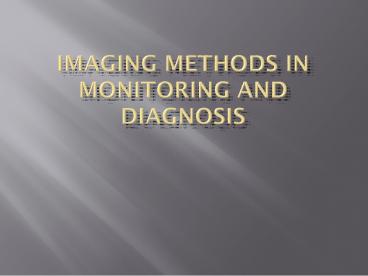Imaging Methods in Monitoring and Diagnosis PowerPoint PPT Presentation
1 / 34
Title: Imaging Methods in Monitoring and Diagnosis
1
Imaging Methods in Monitoring and Diagnosis
2
Imaging Modalities
- X-Rays
- Nuclear Medicine
- Medical Ultrasound
- Magnetic Resonance Imaging
3
X-Rays
4
X-Rays
- Discovered in 1895 by Roentgen
- An ionising radiation at a higher level on EM
spectrum - Higher frequency or shorter wavelength
5
(No Transcript)
6
X-Ray Production
7
(No Transcript)
8
(No Transcript)
9
Plain Digital Radiography
10
Computerised Tomography
11
CT X-ray Beam
12
Helical CT
13
Computerised Tomography
14
(No Transcript)
15
X Rays Pros and Cons
- Non-Invasive
- Well established technology
- Still evolving
- Flexible
- Readily available and therefore relatively cheap
- Ionising Radiation
- Not good at imaging soft tissue on its own
16
Nuclear Medicine
- Use of unsealed radioisotopes
- Attached to pharmaceuticals
- Drugs absorbed preferentially by target organ(s)
- Gamma emitter so can be detected
- Images digitally produced from data gathered
17
Nuclear Medicine Images
18
PET-CT
19
Nuc Med Pros and Cons
- Can image wide variety of tissue types
- Easy to target specific tissue
- Can image function
- Utilises by-products of other processes so cost
effective
- Uses ionising radiation
- Could be described as invasive
- Has many radiation protection issues associated
with it - Better applications are expensive
20
Magnetic Resonance Imaging
- Manipulation of natural magnetic field
- Magnetic resonance is detectable and measurable
- Data detected can be digitally converted to an
image - Utilises tomographic techniques of CT
21
MRI Principle
- Atoms have magnetic moments
- They spin in a magnetic field Precession
- Spin frequency depends on the type of atom or
molecule Larmor Frequency - Examine the spin of hydrogen atoms
- Hydrogen atoms in different tissues have
different Larmor Frequencies
22
MRI Advantages
- Does not use ionising radiation
- Excellent at demonstrating soft tissue
- Non Invasive
- Good at cancer diagnosis
23
MR Imaging
24
Using Data Manipulation
25
Image Manipulation
26
Pros and Cons
- Non-Invasive
- Does not use ionising radiation
- Excellent for soft tissue imaging
- Can image function
- Very Expensive
- Has its own health and safety issues
- Has acceptability issues with some patients
27
Medical Ultrasound
- Utilises sound waves at ultrasonic frequency
- Above 20KHz is ultrasound but usually 3 - 10
MHz for medical imaging purposes - Echoes from tissue can be detected and data
interpreted digitally to produce image - Position and depth of the echoes builds up a
complete picture
28
MU Imaging
29
(No Transcript)
30
Image Manipulation
31
Doppler Imaging
32
Pros and Cons
- Non-Invasive
- No ionising radiation
- Dynamic technique
- Can image soft tissue effectively
- Flexible equipment
- Relatively cheap
- Limited in what can be imaged
- VERY user dependant
33
Which do we use?
- What information do we require?
- Do we wish to see function or structure?
- What can the patient tolerate?
- What would the clinician prefer?
- What is available for use?
- Is there a safer/cheaper alternative?
- Can potential risks be justified?
34
QUESTIONS?

